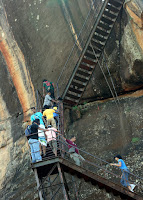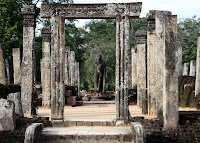 |
| The Lion's Rock at Sigiriya from the water gardens side. |
It is a wrench to leave the cool and scenic highlands of Nuwara Eliya behind and vend our way down to the holy city of Kandy.
 |
| Paddy Fields and Rubber Tapping. |
 |
| Entry Portico and Building The Mansion Kandy. |
 |
| Beautiful Spiral Staircase. |
The vegetation changes from Alpine to Tropical and the wooded mountains give way to lush paddy fields and rubber plantations. Tired of Formula Hotels, we book ourselves into a hundred year old mansion about 8 km from the city, set amidst beautiful gardens and fields. This gracious family home is aptly named, ‘The Mansion’ and is run by a friendly Sister and Brother duo of Uthpala and Pulasthi, the owners of the property, and the manager Senanath.
 |
| Worshippers at the Temple of the Tooth, Kandy. |
 |
| Music for the Gods!. |
 |
| The Tooth Relic casket |
 |
| The Prayer Hall Pillars, Temple of The Tooth. |
 |
| The Spectacular Temple Ceiling. |
 |
| Pilgrims viewing the Tooth Casket. |
 |
| Relaxing at The Mansion. |
 |
| The Bride wore Red. |
 |
| Drummers Greeting the Wedding Party. |
Lazing in the Mansion gardens has its own charm, we were lucky to observe a traditional Sri Lankan Wedding, we also made a day trip to the famous elephant orphanage at Pinnawela, this place, however, was one of the only disappointments in the overall excellent experience in Sri Lanka. The author found the place commercialized and the management brazenly attempting to pressurize visitors into donating money. It is much better to take up a vantage point on the other side of the river to observe groups of elephants bathing and at play.
 |
| Tourists at Dambula Caves. |
Responding to the call of self imposed duty, we move on towards Dambula, Sigiriya and Polonnaruwa, all famous UNESCO World Heritage Sites. The Cave Temple complex at Dambula is signposted by a huge Golden Buddha Statue. One climbs a hill to find that the
 |
| The Golden Buddha, Dambula. |
 |
| The Reclining Buddha, Dambula Cave Temples. |
 |
| The Buddha's Feet. |
The area around the rock is verdant and home to roving bands of monkeys, enjoying grooming themselves and also ready to snatch the odd food packet or fruit from the unwary
 |
| Monkey Business. |
 |
| Buddha Images Dambula |
 |
| Cabanas Jay's Resort, Habarana. |
 |
| Elephant's Rock, Entry to Sigiriya Fortress. |
Sigiriya a monolithic basaltic rock of volcanic magma, towers sheer, rising over
1200 ft from the surrounding plains. This is one of the oldest inhabited sites
in Sri Lanka and has been used through millennia.
The rock contains caves with beautifully
painted frescos, reminiscent of the Ajanta Caves in India. In ancient times the
whole rock was a sort of art gallery, but the older exposed frescos have
undergone tremendous weathering and are almost destroyed. Luckily the cave
frescos survive and are worth going a long way to see. It is another UNESCO
World Heritage Site.
 |
| Exposed Rock Paintings |
 |
| Fresco of a Lady, Sigiriya. |
 |
| Fresco From The Ramayana, Caves at Lion's Rock. |
Ancient Sri Lankan kings recognizing the strategic importance of this sheer sided rock built a strong fortress and shifted the capital here from Anuradhapura. The surrounding plain, too, was developed as parks, gardens and most notably, water gardens some of which can still be viewed in their glory.
 |
| The Lion's Paw. Entry to Sigiriya Fortress. |
 |
| The 'Final Assault' Stair |
 |
| The Steep Spiral Staircase. |
 |
| King Parakramabahu I |
 |
| The Intrepid Author at the Top. |
The ruins of the city stand on the eastern shore of a large artificial lake, the Topa Wewa Lake, or Parakrama Samudra (the Sea of Parakrama), created by King Parakramabahu I (1153-86).
 |
| The Central Buddha Statue. Polonnuruwa. |
 |
| Thuprama, Polonnuruwa |
A scattering of other historic buildings can be found away from the main complex, outside the walls, close to the main road to Dambula.
 |
| Statue among Ruins, Polonnuruwa |
 |
| Temple Door and Staircase Detail. |
 |
| Lake side Restaurant, Polonnuruwa. |
 |
| Rankot Stupa at Polonnuruwa |
 |
| Standing and Reclining Buddha at Gal Vihara, Polonnuruwa. |
We had planned to go to Anuradhapura, but incessant rains and
resultant floods had rendered most up country roads and highways impassable. So
with a heavy heart we turned back towards Colombo, indulging in retail therapy
enroute, in the form of exquisite Dankotuwa China from the factory.
 |
| Hand Carving Wooden Flutes. |
 |
| The Meditating Buddha. |
An airport like all airports, surprisingly reasonable Straight Malt Scotch Whiskey, we indulge over the permissible limit allowed in India, hoping that the customs would overlook it. The push back, the taxi out, the takeoff run, the climb out, a flash of green palms and blue seas and we bid goodbye to the emerald isle.
 |
The Emerald Peacock of The Emerald Isle.
|



Loved every minute of this. Must send the link to my Sri Lankan bestie. History and culture and legend on a grand scale. I am so glad you found Sri Lanka such a great place. The pix make me know I would be synpatico with this glorious country
ReplyDeleteThanks Jamaica Mom. Sri Lanka is a great place to visit as it offers such a wide variety in a small package. The people are friendly and the Price is Great!!!!!.
ReplyDelete